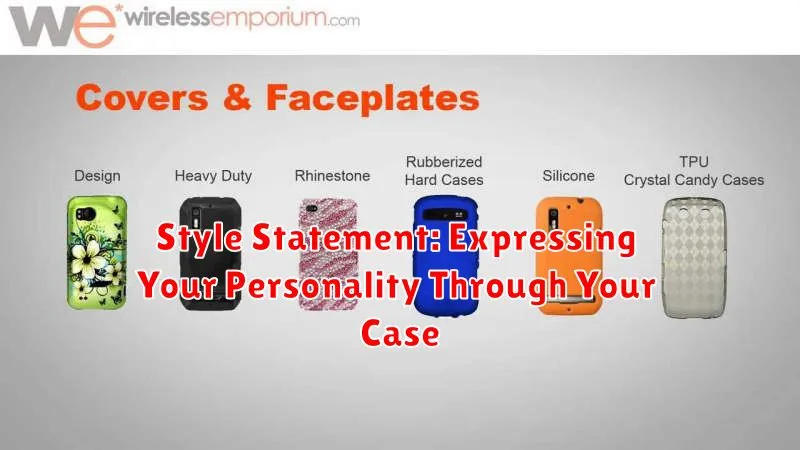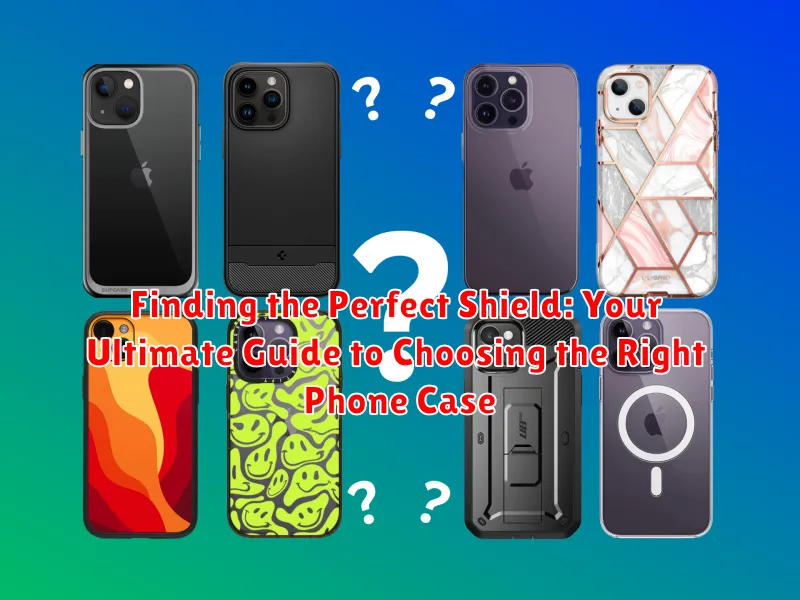In the modern digital age, our smartphones serve as indispensable tools, connecting us to the world and safeguarding a wealth of personal information. Protecting these valuable devices is paramount, and choosing the right phone case is a crucial decision. This comprehensive guide, “Finding the Perfect Shield: Your Ultimate Guide to Choosing the Right Phone Case,” will equip you with the knowledge necessary to navigate the vast market of phone cases and select the perfect shield for your device. Whether you prioritize protection, style, functionality, or a combination of all three, this guide will help you determine the optimal balance to suit your individual needs and preferences. Learn about the different types of phone cases available, the materials they are made of, and the features that set them apart. Discover how to evaluate durability, grip, and compatibility to ensure your phone receives the ultimate defense against daily wear and tear, accidental drops, and other potential hazards.
From slim cases that offer scratch protection to rugged cases designed to withstand extreme conditions, the options can be overwhelming. This guide will break down the complexities of choosing a phone case, explaining the pros and cons of each type. Understand the importance of considering your lifestyle, budget, and the specific model of your phone when making your selection. Explore key features such as screen protectors, kickstands, wallet functionality, and MagSafe compatibility. By the end of this guide, you will be empowered to make an informed decision and confidently select the perfect phone case to provide the ultimate protection and enhance the usability of your cherished device.
Assessing Your Needs: Protection vs. Style
Choosing the right phone case involves balancing your desire for protection with your personal style. Protection focuses on safeguarding your phone from drops, scratches, and other potential damage. Style, on the other hand, reflects your personality and aesthetic preferences.
Consider your lifestyle. Are you prone to dropping your phone? Do you work in a rugged environment? If so, prioritizing robust protection is essential. A thicker, more durable case might be the best choice.
If you value a sleek, minimalist look and are less concerned about extreme drops, a slim, stylish case might be more appealing. These cases offer basic protection against scratches and minor bumps while maintaining a fashionable appearance.
Think about how you use your phone. Do you constantly use it for photography or video recording? Certain cases offer enhanced grips or stands to improve usability. This helps bridge the gap between practicality and aesthetics.
Ultimately, the right balance between protection and style depends entirely on your individual needs and priorities. Carefully assessing these factors will guide you towards the perfect case that complements both your phone and your lifestyle.
Different Types of Phone Cases: Finding Your Match
Navigating the world of phone cases can feel overwhelming. This section breaks down the common types to help you find your perfect match. Consider your lifestyle and priorities when making your selection.
Basic Cases:
Snap-on cases are lightweight and easy to install, offering basic scratch and scuff protection. Silicone cases provide a soft, grippy texture and decent shock absorption.
Protective Cases:
Tough cases are designed for robust protection against drops and impacts, often featuring multiple layers of material. Rugged cases take protection even further, often including reinforced corners and raised edges for screen and camera protection.
Specialty Cases:
Wallet cases combine protection with convenience, offering slots for cards and cash. Battery cases provide extra power on the go. Folio cases offer full-body protection and can often double as a stand.
Material Matters: Exploring Case Materials and Their Benefits
The material of your phone case plays a crucial role in its protective capabilities and overall aesthetic. Choosing the right material depends on your lifestyle and priorities.
Silicone cases are popular for their shock absorption and grip. They offer a soft, comfortable feel and come in various colors. However, they can attract lint and dust.
Plastic cases, often polycarbonate or TPU (thermoplastic polyurethane), provide decent protection against drops and scratches while remaining lightweight. TPU offers better shock absorption compared to hard polycarbonate.
Leather cases offer a premium look and feel. They provide moderate protection against bumps and scratches while developing a unique patina over time. However, they can be more expensive.
Metal cases offer a robust, stylish appearance and excellent protection. However, they can be heavier and may interfere with signal reception.
For ultimate protection, consider hybrid cases, which often combine a hard outer shell (like polycarbonate) with a softer inner layer (like TPU) for maximum impact resistance.
Feature Focus: Built-in Stands, Wallets, and More
Beyond basic protection, phone cases can offer a range of integrated features to enhance convenience and functionality. Consider these options when selecting your ideal case:
Built-in Stands
Kickstands provide hands-free viewing for media consumption or video calls. They can be integrated into the back of the case or fold out for use. Consider the stability and viewing angles offered by different stand designs.
Wallet Cases
For those seeking streamlined organization, wallet cases combine phone protection with card storage. They typically feature slots for credit cards, IDs, and sometimes even cash. Evaluate the number of slots and the security of the closure mechanism.
Other Integrated Features
Some cases offer specialized features like magnetic mounts for car dashboards or detachable batteries for extended power. Think about your daily usage and whether any of these features would significantly benefit you.
Prioritizing Protection: Shock Absorption and Screen Guards
When it comes to phone protection, prioritizing shock absorption and screen protection is paramount. Drop protection is a key feature to consider. Look for cases that utilize impact-absorbing materials and technologies like air cushions or reinforced corners.
Screen guards offer an additional layer of defense against scratches and cracks. Tempered glass screen protectors are highly recommended for their durability and clarity. Consider screen protectors with features like oleophobic coatings to resist fingerprints and smudges.
Military-grade drop protection certification, while not always necessary, can provide added assurance. These cases undergo rigorous testing to ensure they meet specific drop resistance standards. Ultimately, the level of protection you choose will depend on your lifestyle and how prone you are to dropping your phone.
Style Statement: Expressing Your Personality Through Your Case

Your phone case is more than just protection; it’s a fashion accessory. It’s a way to express your individuality and make a statement without saying a word. Consider your personal style. Are you drawn to minimalist designs, bold patterns, or something quirky and unique?
A vast array of options are available, from sleek and sophisticated to fun and vibrant. Think about the colors, textures, and patterns that resonate with you. Do you prefer a classic leather look, a vibrant silicone case, or a tough, rugged design?
Cases can reflect your interests. Whether you’re a sports fanatic, a nature lover, or an art enthusiast, you can find a case that showcases your passions. From sports team logos to intricate floral designs, the possibilities are endless.
Changing your case is also a simple way to update your look and keep things fresh. You can easily swap cases to match your outfit, your mood, or the season.
Budget Considerations: Getting the Best Value for Your Money

Phone cases range in price from a few dollars to over a hundred. Setting a budget beforehand helps narrow down the options and prevents overspending. Consider how much you’re willing to invest in protecting your phone and its aesthetic appeal.
Inexpensive cases offer basic protection against scratches and minor drops, often made of silicone or TPU. While they may not offer the highest level of protection, they can be a good value for budget-conscious buyers.
Mid-range cases provide better protection and may include features like reinforced corners, raised bezels, or dual-layer construction. These cases often balance protection with affordability.
High-end cases boast premium materials like leather, metal, or aramid fiber, and offer advanced protection against drops, shocks, and even extreme conditions. They also often come with added features like built-in wallets or kickstands.
Ensuring Compatibility: Checking Phone Model and Case Fit
Before diving into the aesthetics or features, confirming compatibility is paramount. A beautiful case is useless if it doesn’t fit your phone.
Start by identifying your specific phone model. This information is usually found in your phone’s settings under “About Phone.” Note the exact model name, as even slight variations (like “Pro” or “Max”) can mean significant differences in dimensions.
Once you have the correct model name, double-check the case description to ensure it explicitly states compatibility with your device. Don’t rely solely on images, as they can be generic.
If you’re unsure, contact the case manufacturer or seller to verify compatibility. Providing them with your phone’s model number will ensure a precise match.
Pay close attention to cutouts for ports, buttons, and the camera. A properly fitted case will provide access to all functionalities without obstruction.

